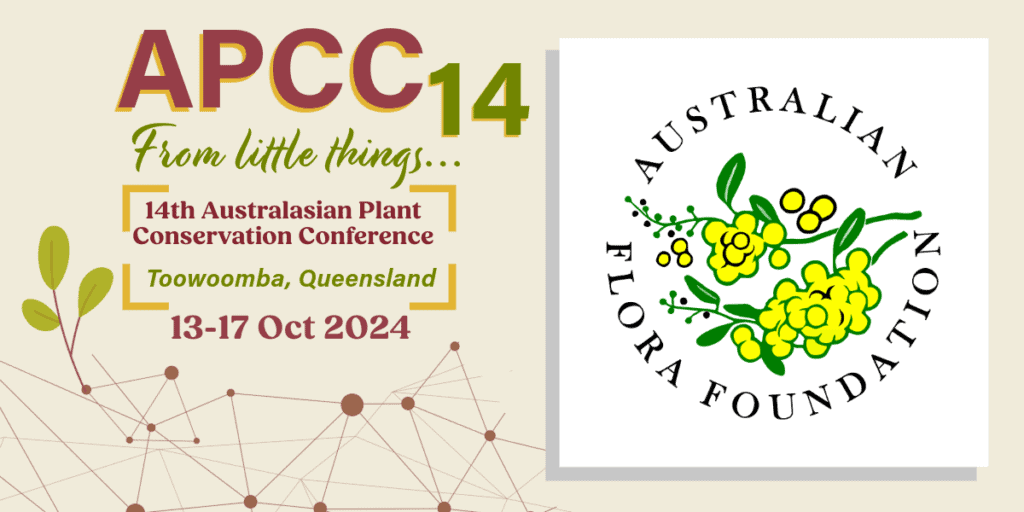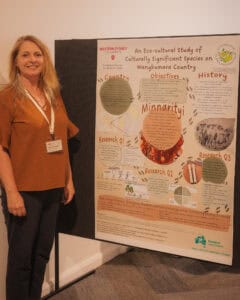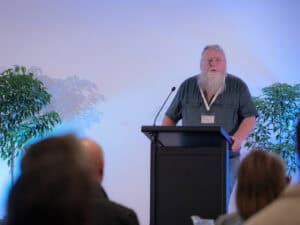
APCC14 Student/Early Career Researcher Bursaries
With the generous support of the Australian Flora Foundation, the ANPC was pleased to be able to award two bursaries of $750 each to two post-graduate students / early career researchers (ECRs) to cover their registration fees and contribute to travel and accommodation costs to attend and present at the 14th Australasian Plant Conservation Conference.
1/ Dr Gabrielle Lebbink completed her PhD at the University of Queensland and is now a plant and invasive species ecologist, working to understand how large-scale disturbances (fire, land use change, herbivores) impact plant communities. By doing so, Gabrielle aims to inform and develop land management strategies to improve conservation values across modified and disturbed landscapes.
Presentation Abstract: The ‘lawnification’ of Australia’s eastern grassy woodlands: the past, current and likely future spread of an invasive perennial grass, Bothriochloa pertusa.
Many of today’s damaging invasive plants were intentionally introduced for pasture development and amenity. By examining the introduction history and consequent spread of these species, we can identify factors associated with their successful establishment and dominance. Using collated presence/absence and cover data, alongside a review of the literature and discussions with land managers, we present a comprehensive analysis of the introduction history and spread of the environmental and agricultural grassy weed Bothriochloa pertusa, (Indian couch) in Queensland. Using this data, we also perform habitat suitability models to predict its potential distribution and local-scale cover across Queensland in relation to key environmental variables. We found that B. pertusa was introduced on multiple occasions and across a large area of Queensland, despite recurring doubts and poor evidence for its benefit to livestock production. Livestock grazing, associated disturbances (i.e. land clearing, soil erosion) and climatic extremes were commonly associated with its spread throughout the landscape. In 2020 the main area of B. pertusa invasion as indicated by occurrence records spanned 28,537,600 ha. Results from the habitat suitability models suggest B. pertusa still has considerable capacity to spread and increase in dominance across many areas of Queensland, particularly west and south of its current range. Our results suggest propagule pressure, traits, climate, land management and cultural perceptions are key factors implicated in the spread of B. pertusa. Where B. pertusa has become dominant there has been a major shift in lifeform from native perennial tussock species to a grazing tolerant stoloniferous species. To slow this process of ‘lawnification’ we recommend more conservative grazing strategies and strategically selected protected areas to maintain cover of grazing sensitive native tussock grass species.
Gabrielle was excited for the opportunity to present this chapter of her PhD which she didn’t get to present during her time as a student.
“Attending the conference was highly relevant for my career development as I will continue working in the space of vegetation ecology and conservation, and as such keeping abreast of the current projects and networking with colleagues in this space is crucial and important for developing collaborative research projects in the future.”
2/ Ms Mirritya Ebsworth is a proud Paakantyi/Wangkumara woman with science, teaching, and linguistic qualifications, dedicated to investigating the cultural importance of totem species. Her work aims to ensure that her mob can preserve and pass on cultural knowledge to future generations.
Poster Abstract: An Eco-cultural Study of Culturally Significant Species on Wangkumara Country
Wangkumara Country is located in the Cooper Basin, in south-west Queensland. Native Title was granted to Wangkumara people in July 2024. This PhD project is an eco-cultural assessment of my Grandfather’s country. Understanding the ecological condition of our ancestral lands will encourage my mob to return to Country to resume our cultural practices. Minnarityi (Acacia cyperophylla or red mulga) is a culturally significant species found only in arid and semi-arid areas of central Australia. Wangkumara people used it for tools, weapons, shelter, ceremony, and food acquisition. Very little is currently recorded in the literature about the ecology of minnarityi on Wangkumara Country. This study will compare the population dynamics of minnarityi across land use types using two-way science, including contemporary quantitative and qualitative ecological assessment tools and Aboriginal traditional ecological knowledge (TEK). The anticipated outcomes of the project include:
- the development of culture-based conservation strategies.
- educational resources that will enable Wangkumara people to reconnect with Country and to understand their cultural responsibilities in caring for Country.
- recommendations for collaborative conservation to protect ecosystems on Wangkumara Country.
This project is also a platform for revitalising Wangkumara language and will preserve cultural knowledge for future generations. With greater two-way understanding, the results of the project will help develop strategies that empower Wangkumara people and improve the condition of our ancestral lands.
“Attending the APCC14 conference was a deeply rewarding and enjoyable experience for me, particularly as a new entrant to the field. The sessions were insightful, providing a wealth of knowledge that I’m excited to incorporate into my work, as evidenced by the extensive pages of notes I took during the event. Beyond the learning, I was able to network and connect with some wonderful people, which enriched the experience even further. I would like to extend a heartfelt thanks to the conference organisers for the exceptional quality of the event, and to the Australian Flora Foundation for their generous bursary, which allowed me to attend. This support was truly a gift, and I am immensely grateful for the opportunity. Thank you once again for an unforgettable experience.”

With the generous support of the Queensland Government, the ANPC was pleased to award a third post-graduate student / ECR bursary of $750.
3/ Mr Peter Pemberton has tertiary qualifications in Information Technology and Ecology and Environmental Management. He is now a mature aged student at the UNE, utilising both his computer and ecology skills to complete a PhD researching molecular ecology of outcrop endemic flora. Co-authors: Dr Rose Andrew, Dr Manu Saunders, Dr John Hunter, Dr Liz Wandrag 
Presentation Abstract: Molecular ecology of endemic shrubs in isolated OCBIL populations
Old Climatically Buffered Landscapes (OCBILs) often exist as terrestrial islands that are isolated in a larger landscape matrix, and plants confined to OCBILs have a high incidence of endemicity and rarity. Shrubs are a significant component of OCBIL vegetation, and many have restricted gene flow due to short distance autochory (self-driven) seed dispersal mechanisms, and a reliance on insect pollinators with limited ranges. We hypothesise that the persistence of these shrub species in small and isolated populations limits the adaptive potential that arises from gene flow between populations. We conducted a systematic literature review to identify the breadth of molecular ecology research on OCBIL flora species. We identified geographic gaps and a paucity of studies focusing on shrubs. Species documented as insect-pollinated tended to have highly structured populations with low gene migration rates, underlining the need to understand how OCBIL flora diversify and persist. Complementing this review, we are researching the genetic diversity and gene flow of OCBIL shrubs at multiple scales in the New England Tableland region, an ecologically significant OCBIL region of Australia. Fine-scale analysis of relatedness and spatial autocorrelation at centimetre precision will investigate patterns of gene flow and dispersal within a granite outcrop population. In concert with observations of flower visitors, comparisons among age cohorts will illustrate the influence of geography and insect-mediated pollination on gene flow at the finest scale. This research sheds light on the mechanisms by which small, isolated populations may persist.
“The APCC14 conference provided an excellent opportunity for me to meet Prof Steve Hopper in person and discuss OCBILs with him, which was of great benefit to myself and my research project. The bursary gave me the opportunity to present my research at a significant conference, and enjoy the quality of the interesting presentations the conference offered. I thoroughly enjoyed Costa’s energy and enthusiasm as the guest speaker. So a massive thank-you to the organisers for a great conference, and thank you for the bursary that allowed me to attend.”
